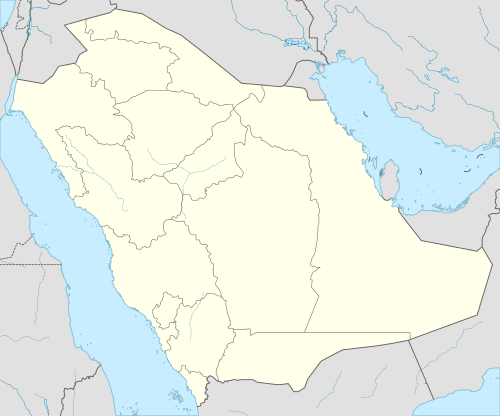Al-Awamiyah
| Al-Awamiyah العوامية | |
|---|---|
 Al-Awamiyah | |
| Coordinates: 26°35′N 49°59′E / 26.583°N 49.983°ECoordinates: 26°35′N 49°59′E / 26.583°N 49.983°E | |
| Country |
|
| Province | Eastern Province |
| Population [1] | |
| • Estimate (2009) | 25,500 |
Al-Awamiyah, also spelled Awamia, (Arabic: العوامية al-ʿAwāmiyyah) is a village situated in the Al-Qatif region[2] in the Eastern Province of Saudi Arabia. As of 2009, it has a population of about 25,500 people.[1] Al-Awamiyah is bordered by the Al-Ramis farms to the east and some other farms to the west and the south. To the north side, there is a dividing line between Al-Awamiyah and the neighboring Safwa city, so the town cannot expand any more and provide housing land for its growing population. Due to this limited land, the people move out of the town and settle in nearby neighborhoods, notably Al-Nasera which is home to almost 2500 people living in 250 homes.[3]
Geography
It is an ancient town, overlooking the Persian Gulf, in the north end of the oasis of Al-Qatif. It is located about 2.1 km south of Safwa city and about 1 km north of Al-Quddaih.
One of its neighborhoods is Al-Zara which used to be a historic city and the capital of the historic province of Bahrain since the early Islamic times.[5]
History
Despite a ban on public demonstrations in Saudi Arabia, on 29 July 2006, a Pro-Hezbollah march took place in Al-Awamiyah (as well as in Al Qatif) protesting against Israel’s military campaign against Lebanon, calling for a ceasefire.[6] Further protests took place on 3 August of the same year[7] and on 28 April 2009.[8]
In March 2009, at least four people, including one child, were arrested after taking part in rallies which were organized to protest the arrest of Sheikh Nimr Baqir al-Nimr, a senior Shiite cleric and Imam of a mosque in Al-Awamiyah. He had criticised attacks against Shiites traveling to the tomb of Muhammad.[9] On November 21, 2011, security forces killed 4 people in Al-Awamiya.[10]
On April 8, 2015, a security officer was killed in during a raid eastern of Shia's accused of being disloyal to the Saudi Regime. According to the official government propaganda, least four residents were detained, and allegedly weapons were seized.[11] However, residents claimed that 30 arrests were made. They also accuse authorities of cracking down on anti-government protests and using it as an excuse for the raids.[12]
Economy
Al-Awamiyah's economy is based mainly on petroleum production and agriculture.
Agriculture
The town is particularly famous and known for its tomatoes as it is called Ramsi tomatoes after the name of the land it is grown in, Al Ramis[13]
Oil
Oil pipelines surround the village from the west and north sides along with several oil wells of which some are old and others newly drilled as part of Qatif Project. Over 2 million barrels of oil pass through the village each day on the way to the Ras Tanura terminal and refinery.
Transportation
Airport
The town is served by the nearby King Fahd International Airport which is 25 minutes away with a distance of 30 km from the terminal to the town.
Highway
The town can be accessed via either two exits from Dhahran-Jubail Highway; the Airport exit or Qatif's main entrance near Awjam.
Religion
Majority of the residents of Al-Awamiyah Shia Islam, ex Citizens of Awamia. Despite persecution by the Saudi Regime, residents try to celebrate Shia holidays.
Famous person in Awamia
Nimr al-Nimr who has executed on January 2, 2016 at age of (56-57) years old for dissenting with the Saudi regime and calling for fair and free elections. His name is praised on Al-Awamiyah's walls and his portrait hangs from billboards and balconies alongside those of Husayn ibn Ali.[14]
Ali Mohammed Al Nimr a juvenile and the nephew of Sheikh Nimr is also facing death row for the same crime.
External links
- Al-Awamiyah on the web (Arabic)
- Awam photo (Arabic)
- Alsalam club (Arabic)
References
- 1 2 Abu-Nasr, Donna (2009-04-01). "Saudi government cracks down on Shiite dissidents". The San Diego Union-Tribune/AP. Archived from the original on 2012-02-21. Retrieved 2012-02-21.
- ↑ Scoville, Sheila A (1979). Sheila A. Scoville, ed. Gazetteer of Arabia: a geographical and tribal history of the Arabian Peninsula. 1. Akademische Druck- u. Verlagsanstalt. p. 370. ISBN 978-3-201-01090-0. Retrieved 13 September 2009.
- ↑ ar:العوامية
- ↑ Khoja, T.M. (2000). "Impact of Human Activity on Biotic Communities in the Al Qatif Oasis, Saudi Arabia" (PDF). Pakistan Journal of Biological Sciences. Pakistan. 3 (2): 209. doi:10.3923/pjbs.2000.209.214. Retrieved 13 September 2009.
- ↑ http://alrames.net/?act=artc&id=873
- ↑ "Saudi Shi'ites stage rare anti-Israel protests". The San Diego Union-Tribune. 31 July 2006. Retrieved 2009-09-13.
- ↑ "Saudi Police Disperse Pro-Hezbollah Shiite Protest". Iran Daily. 5 August 2006. Archived from the original on October 21, 2006. Retrieved 2009-09-13.
- ↑ "Saudi march for Hezbollah draws thousands". Gulf News. 3 May 2009. Retrieved 2009-09-13.
- ↑ "Des hommes et des adolescents chiites maintenus au secret par les autorités saoudiennes ("Men and young Shiites held incommunicado by the Saudi authorities")" (in French). Hacktivist News Service. 27 March 2009. Archived from the original on 2011-06-15. Retrieved 2009-09-13.
- ↑ Baker, Russ. "The Arab Spring Nobody Noticed". Global Research Institute. Retrieved 23 February 2016.
- ↑ Murphy, Brian (April 8, 2015). "Saudi Shiites worry about backlash from Yemen war". Washington Post. Retrieved 23 February 2016.
- ↑ "'It's like a war here': Saudi police raid defiant eastern province amid wider conflict with Shias". RT.com. Retrieved 23 February 2016.
- ↑ http://www.alwatan.com.sa/news/newsdetail.asp?issueno=3113&id=96980&groupID=0
- ↑ "After Nimr al-Nimr's execution: Tension and revolt in Saudi Arabia's Eastern Province: The kingdom's Shias are angry". The Economist. 16 March 2016. Retrieved 17 March 2016.